Deck 10: Externalities
Question
Question
Question
Question
Question
Question
Question
Question
Question
Question
Question
Question
Question
Question
Question
Question
Question
Question
Question
Question
Question
Question
Question
Question
Question
Question
Question
Question
Question
Question
Question
Question
Question
Question
Question
Question
Question
Question
Question
Question
Question
Question
Question
Question
Question
Question
Question
Question
Question
Question
Question
Question
Question
Question
Question
Question
Question
Question
Question
Question
Question
Question
Question
Question
Question
Question
Question
Question
Question
Question

Unlock Deck
Sign up to unlock the cards in this deck!
Unlock Deck
Unlock Deck
1/70
Play
Full screen (f)
Deck 10: Externalities
1
The impact of one person's actions on the well-being of a bystander is called
A)an economic dilemma.
B)deadweight loss.
C)a multi-party problem.
D)an externality.
A)an economic dilemma.
B)deadweight loss.
C)a multi-party problem.
D)an externality.
D
2
In a market economy,government intervention
A)will always improve market outcomes.
B)reduces efficiency in the presence of externalities.
C)may improve market outcomes in the presence of externalities.
D)is necessary to control individual greed.
A)will always improve market outcomes.
B)reduces efficiency in the presence of externalities.
C)may improve market outcomes in the presence of externalities.
D)is necessary to control individual greed.
C
3
Figure 10-7 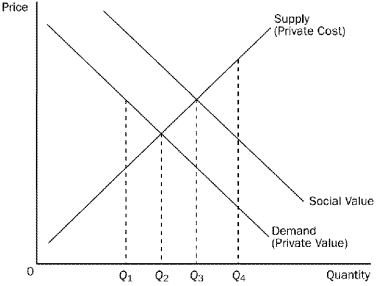
Refer to Figure 10-7.To internalize the externality in this market,the government should
A)impose a tax on this product.
B)provide a subsidy for this product.
C)forbid production.
D)produce the product itself.

Refer to Figure 10-7.To internalize the externality in this market,the government should
A)impose a tax on this product.
B)provide a subsidy for this product.
C)forbid production.
D)produce the product itself.
B
4
An optimal tax on pollution would result in which of the following?
A)Producers will choose not to produce any pollution.
B)Producers will internalize the cost of the pollution.
C)Producers will maximize production.
D)The value to consumers at market equilibrium will exceed the social cost of production.
A)Producers will choose not to produce any pollution.
B)Producers will internalize the cost of the pollution.
C)Producers will maximize production.
D)The value to consumers at market equilibrium will exceed the social cost of production.

Unlock Deck
Unlock for access to all 70 flashcards in this deck.
Unlock Deck
k this deck
5
Suppose that a negative externality is created by the production of good X.Which of the following statements is correct?
A)The social cost of producing good X includes the private cost plus the cost to bystanders of the externality.
B)The increased social cost can be graphed as a decrease in demand.
C)The market equilibrium quantity will be the socially optimal quantity as long as the government does not interfere.
D)Both a and b are correct.
A)The social cost of producing good X includes the private cost plus the cost to bystanders of the externality.
B)The increased social cost can be graphed as a decrease in demand.
C)The market equilibrium quantity will be the socially optimal quantity as long as the government does not interfere.
D)Both a and b are correct.

Unlock Deck
Unlock for access to all 70 flashcards in this deck.
Unlock Deck
k this deck
6
Externalities tend to cause markets to be
A)inefficient.
B)unequal.
C)unnecessary.
D)overwhelmed.
A)inefficient.
B)unequal.
C)unnecessary.
D)overwhelmed.

Unlock Deck
Unlock for access to all 70 flashcards in this deck.
Unlock Deck
k this deck
7
Figure 10-4 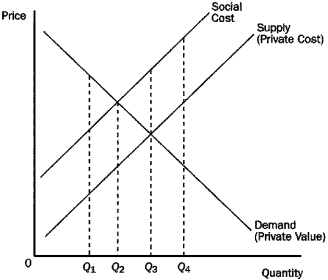
Refer to Figure 10-4.This market is characterized by
A)government intervention.
B)a positive externality.
C)a negative externality.
D)None of the above is correct.

Refer to Figure 10-4.This market is characterized by
A)government intervention.
B)a positive externality.
C)a negative externality.
D)None of the above is correct.

Unlock Deck
Unlock for access to all 70 flashcards in this deck.
Unlock Deck
k this deck
8
When a negative externality exists in a market,the cost to producers
A)is greater than the cost to society.
B)will be the same as the cost to society.
C)will be less than the cost to society.
D)will differ from the cost to society,regardless of whether an externality is present.
A)is greater than the cost to society.
B)will be the same as the cost to society.
C)will be less than the cost to society.
D)will differ from the cost to society,regardless of whether an externality is present.

Unlock Deck
Unlock for access to all 70 flashcards in this deck.
Unlock Deck
k this deck
9
Figure 10-2.The graph depicts the market for plastic. 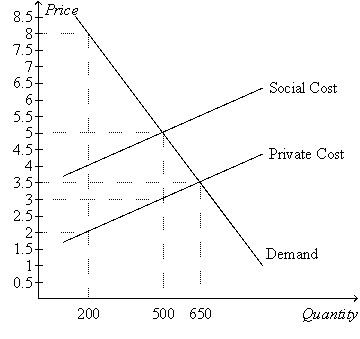
Refer to Figure 10-2.Suppose that the production of plastic creates a social cost which is depicted in the graph above.What is the socially optimal quantity of plastic?
A)200 units
B)450 units
C)500 units
D)650 units

Refer to Figure 10-2.Suppose that the production of plastic creates a social cost which is depicted in the graph above.What is the socially optimal quantity of plastic?
A)200 units
B)450 units
C)500 units
D)650 units

Unlock Deck
Unlock for access to all 70 flashcards in this deck.
Unlock Deck
k this deck
10
All remedies for externalities share the goal of
A)moving the allocation of resources toward the market equilibrium.
B)moving the allocation of resources toward the socially optimal equilibrium.
C)increasing the allocation of resources.
D)decreasing the allocation of resources.
A)moving the allocation of resources toward the market equilibrium.
B)moving the allocation of resources toward the socially optimal equilibrium.
C)increasing the allocation of resources.
D)decreasing the allocation of resources.

Unlock Deck
Unlock for access to all 70 flashcards in this deck.
Unlock Deck
k this deck
11
Figure 10-7 
Refer to Figure 10-7.Which quantity represents the social optimum for this market?
A)Q1.
B)Q2.
C)Q3.
D)Q4.

Refer to Figure 10-7.Which quantity represents the social optimum for this market?
A)Q1.
B)Q2.
C)Q3.
D)Q4.

Unlock Deck
Unlock for access to all 70 flashcards in this deck.
Unlock Deck
k this deck
12
Figure 10-2.The graph depicts the market for plastic. 
Refer to Figure 10-2.Suppose that the production of plastic creates a social cost which is depicted in the graph above.Without any government regulation,how much plastic will be produced?
A)200
B)500
C)650
D)900

Refer to Figure 10-2.Suppose that the production of plastic creates a social cost which is depicted in the graph above.Without any government regulation,how much plastic will be produced?
A)200
B)500
C)650
D)900

Unlock Deck
Unlock for access to all 70 flashcards in this deck.
Unlock Deck
k this deck
13
When externalities are present in a market,the well-being of market participants
A)and market bystanders are both directly affected.
B)and market bystanders are both indirectly affected.
C)is directly affected,and market bystanders are indirectly affected.
D)is indirectly affected,and market bystanders are directly affected.
A)and market bystanders are both directly affected.
B)and market bystanders are both indirectly affected.
C)is directly affected,and market bystanders are indirectly affected.
D)is indirectly affected,and market bystanders are directly affected.

Unlock Deck
Unlock for access to all 70 flashcards in this deck.
Unlock Deck
k this deck
14
When the production of a good results in a positive externality,the social value curve is
A)below the demand curve,indicating that the total value to society is less than the private benefit.
B)above the demand curve,indicating that the total value to society is greater than the private benefit.
C)identical to the demand curve,indicating that the total cost to society is the equal to the private benefit.
D)above the supply curve,indicating that the total cost to society exceeds the private cost.
A)below the demand curve,indicating that the total value to society is less than the private benefit.
B)above the demand curve,indicating that the total value to society is greater than the private benefit.
C)identical to the demand curve,indicating that the total cost to society is the equal to the private benefit.
D)above the supply curve,indicating that the total cost to society exceeds the private cost.

Unlock Deck
Unlock for access to all 70 flashcards in this deck.
Unlock Deck
k this deck
15
Internalizing a positive externality will cause the demand curve to
A)shift to the right.
B)shift to the left.
C)become more elastic.
D)remain unchanged.
A)shift to the right.
B)shift to the left.
C)become more elastic.
D)remain unchanged.

Unlock Deck
Unlock for access to all 70 flashcards in this deck.
Unlock Deck
k this deck
16
The term market failure refers to
A)a market that fails to allocate resources efficiently.
B)an unsuccessful advertising campaign which reduces demand.
C)ruthless competition among firms.
D)a firm that is forced out of business because of losses.s
A)a market that fails to allocate resources efficiently.
B)an unsuccessful advertising campaign which reduces demand.
C)ruthless competition among firms.
D)a firm that is forced out of business because of losses.s

Unlock Deck
Unlock for access to all 70 flashcards in this deck.
Unlock Deck
k this deck
17
Figure 10-4 
Refer to Figure 10-4.If this market is currently producing at Q4,then total economic well-being would be maximized if output
A)decreased to Q1.
B)decreased to Q2.
C)decreased to Q3.
D)stayed at Q4.

Refer to Figure 10-4.If this market is currently producing at Q4,then total economic well-being would be maximized if output
A)decreased to Q1.
B)decreased to Q2.
C)decreased to Q3.
D)stayed at Q4.

Unlock Deck
Unlock for access to all 70 flashcards in this deck.
Unlock Deck
k this deck
18
Which of the following is an example of a positive externality?
A)air pollution
B)a person littering in a public park
C)a nice garden in front of your neighbor's house
D)the pollution of a stream
A)air pollution
B)a person littering in a public park
C)a nice garden in front of your neighbor's house
D)the pollution of a stream

Unlock Deck
Unlock for access to all 70 flashcards in this deck.
Unlock Deck
k this deck
19
The difference between social cost and private cost is a measure of the
A)loss in profit to the seller as the result of a negative externality.
B)cost of an externality.
C)cost reduction when the negative externality is eliminated.
D)cost incurred by the government when it intervenes in the market.
A)loss in profit to the seller as the result of a negative externality.
B)cost of an externality.
C)cost reduction when the negative externality is eliminated.
D)cost incurred by the government when it intervenes in the market.

Unlock Deck
Unlock for access to all 70 flashcards in this deck.
Unlock Deck
k this deck
20
Markets are often inefficient when negative externalities are present because
A)private costs exceed social costs at the private market solution.
B)externalities cannot be corrected without government regulation.
C)social costs exceed private costs at the private market solution.
D)production externalities lead to consumption externalities.
A)private costs exceed social costs at the private market solution.
B)externalities cannot be corrected without government regulation.
C)social costs exceed private costs at the private market solution.
D)production externalities lead to consumption externalities.

Unlock Deck
Unlock for access to all 70 flashcards in this deck.
Unlock Deck
k this deck
21
Figure 10-12 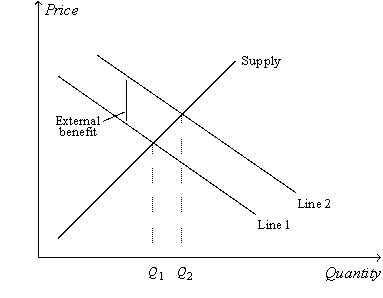
Refer to Figure 10-12.Which of the following is an appropriate label for Line 1?
A)social cost
B)social value
C)private cost
D)private value

Refer to Figure 10-12.Which of the following is an appropriate label for Line 1?
A)social cost
B)social value
C)private cost
D)private value

Unlock Deck
Unlock for access to all 70 flashcards in this deck.
Unlock Deck
k this deck
22
Which of the following is an advantage of tradable pollution permits?
A)Each firm is allowed to pollute exactly the same amount.
B)Revenue from the sale of permits is greater than revenue from a corrective tax.
C)The initial allocation of permits to firms does not affect the efficiency of the market.
D)Firms will engage in joint research efforts to reduce pollution.
A)Each firm is allowed to pollute exactly the same amount.
B)Revenue from the sale of permits is greater than revenue from a corrective tax.
C)The initial allocation of permits to firms does not affect the efficiency of the market.
D)Firms will engage in joint research efforts to reduce pollution.

Unlock Deck
Unlock for access to all 70 flashcards in this deck.
Unlock Deck
k this deck
23
Suppose that elementary education creates a positive externality.If the government subsidizes education by an amount equal to the per-unit externality it creates,then
A)the equilibrium quantity of education will equal the socially optimal quantity of education.
B)the equilibrium quantity of education will be greater than the socially optimal quantity of education.
C)the equilibrium quantity of education will be less than the socially optimal quantity of education.
D)There is not enough information to answer the question.
A)the equilibrium quantity of education will equal the socially optimal quantity of education.
B)the equilibrium quantity of education will be greater than the socially optimal quantity of education.
C)the equilibrium quantity of education will be less than the socially optimal quantity of education.
D)There is not enough information to answer the question.

Unlock Deck
Unlock for access to all 70 flashcards in this deck.
Unlock Deck
k this deck
24
Figure 10-10 
Refer to Figure 10-10.An increase in output from 120 units to 160 units would
A)move the market from a socially efficient outcome to a socially inefficient outcome.
B)increase the external cost per unit of output.
C)increase total economic well-being.
D)be an action of which a benevolent social planner would approve.

Refer to Figure 10-10.An increase in output from 120 units to 160 units would
A)move the market from a socially efficient outcome to a socially inefficient outcome.
B)increase the external cost per unit of output.
C)increase total economic well-being.
D)be an action of which a benevolent social planner would approve.

Unlock Deck
Unlock for access to all 70 flashcards in this deck.
Unlock Deck
k this deck
25
Since almost all forms of transportation produce some type of pollution,
A)the government should ban all transportation.
B)the government should ban all pollution.
C)society has to weigh the cost and benefits when deciding how much pollution to allow.
D)refrain from intervening because the market can best solve this problem.
A)the government should ban all transportation.
B)the government should ban all pollution.
C)society has to weigh the cost and benefits when deciding how much pollution to allow.
D)refrain from intervening because the market can best solve this problem.

Unlock Deck
Unlock for access to all 70 flashcards in this deck.
Unlock Deck
k this deck
26
A patent is used to
A)disseminate information.
B)offset the negative effects of taxes.
C)protect inventors for as long as they live.
D)assign property rights.
A)disseminate information.
B)offset the negative effects of taxes.
C)protect inventors for as long as they live.
D)assign property rights.

Unlock Deck
Unlock for access to all 70 flashcards in this deck.
Unlock Deck
k this deck
27
Suppose that an MBA degree creates no externality because the benefits of an MBA are internalized by the student in the form of higher wages.If there are no government subsidies for MBAs,then which of the following statements is correct?
A)The equilibrium quantity of MBAs will equal the socially optimal quantity of MBAs.
B)The equilibrium quantity of MBAs will be greater than the socially optimal quantity of MBAs.
C)The equilibrium quantity of MBAs will be less than the socially optimal quantity of MBAs.
D)There is not enough information to answer the question.
A)The equilibrium quantity of MBAs will equal the socially optimal quantity of MBAs.
B)The equilibrium quantity of MBAs will be greater than the socially optimal quantity of MBAs.
C)The equilibrium quantity of MBAs will be less than the socially optimal quantity of MBAs.
D)There is not enough information to answer the question.

Unlock Deck
Unlock for access to all 70 flashcards in this deck.
Unlock Deck
k this deck
28
Which of the following is a way to address an externality problem?
A)command and control solution
B)corrective tax
C)corrective subsidy
D)all of the above.
A)command and control solution
B)corrective tax
C)corrective subsidy
D)all of the above.

Unlock Deck
Unlock for access to all 70 flashcards in this deck.
Unlock Deck
k this deck
29
Figure 10-15 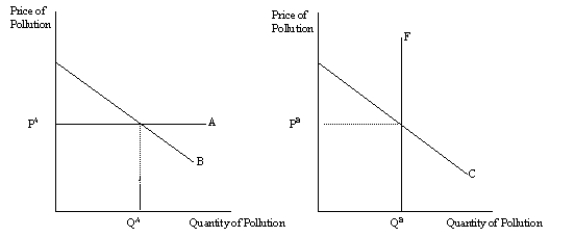
Refer to Figure 10-15.The supply of pollution permits is
A)elastic and represented by line A.
B)inelastic and represented by line A.
C)elastic and represented by line F
D)inelastic and represented by line F.

Refer to Figure 10-15.The supply of pollution permits is
A)elastic and represented by line A.
B)inelastic and represented by line A.
C)elastic and represented by line F
D)inelastic and represented by line F.

Unlock Deck
Unlock for access to all 70 flashcards in this deck.
Unlock Deck
k this deck
30
The difference between a corrective tax and a tradable pollution permit is that
A)a corrective tax sets the price of pollution and a permit sets the quantity of pollution.
B)a corrective tax creates a more efficient outcome than a permit.
C)a corrective tax sets the quantity of pollution and a permit sets the price of pollution.
D)a permit creates a more efficient outcome than a corrective tax.
A)a corrective tax sets the price of pollution and a permit sets the quantity of pollution.
B)a corrective tax creates a more efficient outcome than a permit.
C)a corrective tax sets the quantity of pollution and a permit sets the price of pollution.
D)a permit creates a more efficient outcome than a corrective tax.

Unlock Deck
Unlock for access to all 70 flashcards in this deck.
Unlock Deck
k this deck
31
Technology spillover is one type of
A)negative externality.
B)positive externality.
C)subsidy.
D)producer surplus.
A)negative externality.
B)positive externality.
C)subsidy.
D)producer surplus.

Unlock Deck
Unlock for access to all 70 flashcards in this deck.
Unlock Deck
k this deck
32
When the government uses a command-and-control policy to solve an externality,it
A)is usually the most effective policy option available.
B)creates policies that directly regulate behavior.
C)usually involves taxing the consumption of a commodity.
D)typically refers to the Coase theorem to structure the policy.
A)is usually the most effective policy option available.
B)creates policies that directly regulate behavior.
C)usually involves taxing the consumption of a commodity.
D)typically refers to the Coase theorem to structure the policy.

Unlock Deck
Unlock for access to all 70 flashcards in this deck.
Unlock Deck
k this deck
33
Figure 10-10 
Refer to Figure 10-10.The graph represents a market in which
A)there is no externality.
B)there is a positive externality.
C)there is a negative externality.
D)The answer cannot be determined from inspection of the graph.

Refer to Figure 10-10.The graph represents a market in which
A)there is no externality.
B)there is a positive externality.
C)there is a negative externality.
D)The answer cannot be determined from inspection of the graph.

Unlock Deck
Unlock for access to all 70 flashcards in this deck.
Unlock Deck
k this deck
34
When technology spillover occurs,
A)it is the government's responsibility to own firms that are engaged in high-tech research.
B)a firm's research yields technological knowledge that can then be used by society as a whole.
C)those firms engaged in technology research should be taxed by the government.
D)firms invest in the latest production technology and the cost of that technology "spills over" to the prices consumers must pay for the product.
A)it is the government's responsibility to own firms that are engaged in high-tech research.
B)a firm's research yields technological knowledge that can then be used by society as a whole.
C)those firms engaged in technology research should be taxed by the government.
D)firms invest in the latest production technology and the cost of that technology "spills over" to the prices consumers must pay for the product.

Unlock Deck
Unlock for access to all 70 flashcards in this deck.
Unlock Deck
k this deck
35
Corrective taxes differ from most taxes in that corrective taxes
A)enhance economic efficiency.
B)do not raise revenue for the government.
C)cause deadweight loss.
D)cannot be divided between the buyer and seller.
A)enhance economic efficiency.
B)do not raise revenue for the government.
C)cause deadweight loss.
D)cannot be divided between the buyer and seller.

Unlock Deck
Unlock for access to all 70 flashcards in this deck.
Unlock Deck
k this deck
36
If education produces positive externalities,we would expect
A)the government to tax education.
B)the government to subsidize education.
C)people to realize the benefits,which would increase the demand for education.
D)colleges to relax admission requirements.
A)the government to tax education.
B)the government to subsidize education.
C)people to realize the benefits,which would increase the demand for education.
D)colleges to relax admission requirements.

Unlock Deck
Unlock for access to all 70 flashcards in this deck.
Unlock Deck
k this deck
37
Figure 10-15 
Refer to Figure 10-15.Which graph illustrates a pollution permit program?
A)the left graph
B)the right graph
C)both graphs
D)neither graph

Refer to Figure 10-15.Which graph illustrates a pollution permit program?
A)the left graph
B)the right graph
C)both graphs
D)neither graph

Unlock Deck
Unlock for access to all 70 flashcards in this deck.
Unlock Deck
k this deck
38
Two firms,A and B,each currently dump 20 tons of chemicals into the local river.The government has decided to reduce the pollution and from now on will require a pollution permit for each ton of pollution dumped into the river.The government gives each firm 10 pollution permits,which it can either use or sell to the other firm.It costs Firm A $100 for each ton of pollution that it eliminates before it reaches the river,and it costs Firm B $50 for each ton of pollution that it eliminates before it reaches the river.After the two firms buy or sell pollution permits from each other,we would expect that
A)Firm A will no longer pollute,and Firm B will not reduce its pollution at all.
B)Firm B will no longer pollute,and Firm A will not reduce its pollution at all.
C)Firm A will dump 10 tons of pollution into the river,and Firm B will dump 10 tons of pollution into the river.
D)Firm A will increase its pollution and Firm B will reduce its pollution.
A)Firm A will no longer pollute,and Firm B will not reduce its pollution at all.
B)Firm B will no longer pollute,and Firm A will not reduce its pollution at all.
C)Firm A will dump 10 tons of pollution into the river,and Firm B will dump 10 tons of pollution into the river.
D)Firm A will increase its pollution and Firm B will reduce its pollution.

Unlock Deck
Unlock for access to all 70 flashcards in this deck.
Unlock Deck
k this deck
39
Public Policies Toward Externalities
Figure 10-14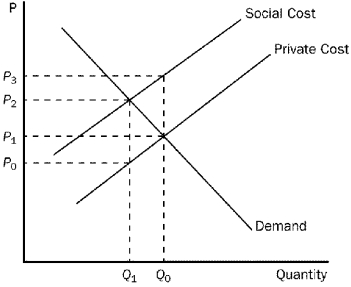
Refer to Figure 10-14.Which of the following statements is correct?
A)To induce firms to internalize the externality in this market,the government should impose a tax measured by P2 - P0.
B)To induce firms to internalize the externality in this market,the government should offer a subsidy measured by P2 - P0.
C)To induce firms to internalize the externality in this market,the government should impose a tax measured by P2 - P1.
D)There is no externality in this market.
Figure 10-14

Refer to Figure 10-14.Which of the following statements is correct?
A)To induce firms to internalize the externality in this market,the government should impose a tax measured by P2 - P0.
B)To induce firms to internalize the externality in this market,the government should offer a subsidy measured by P2 - P0.
C)To induce firms to internalize the externality in this market,the government should impose a tax measured by P2 - P1.
D)There is no externality in this market.

Unlock Deck
Unlock for access to all 70 flashcards in this deck.
Unlock Deck
k this deck
40
Figure 10-15 
Refer to Figure 10-15.Which graph illustrates a corrective tax?
A)the left graph
B)the right graph
C)both graphs
D)neither graph

Refer to Figure 10-15.Which graph illustrates a corrective tax?
A)the left graph
B)the right graph
C)both graphs
D)neither graph

Unlock Deck
Unlock for access to all 70 flashcards in this deck.
Unlock Deck
k this deck
41
For the purpose of protecting the environment,upon which of the following approaches do we rely more and more as time goes by?
A)adherence to the notion of the invisible hand
B)command-and-control policies
C)the development and enforcement of regulations
D)the requirement that decision makers bear the full costs of their actions
A)adherence to the notion of the invisible hand
B)command-and-control policies
C)the development and enforcement of regulations
D)the requirement that decision makers bear the full costs of their actions

Unlock Deck
Unlock for access to all 70 flashcards in this deck.
Unlock Deck
k this deck
42
That some firms are engaged in more than one type of business is explained,in some cases,by
A)moral injunctions such as the Golden Rule.
B)the existence of charitable organizations.
C)government regulations that discourage the internalization of externalities.
D)the fact that the internalization of externalities sometimes coincides with the self-interest of the relevant parties.
A)moral injunctions such as the Golden Rule.
B)the existence of charitable organizations.
C)government regulations that discourage the internalization of externalities.
D)the fact that the internalization of externalities sometimes coincides with the self-interest of the relevant parties.

Unlock Deck
Unlock for access to all 70 flashcards in this deck.
Unlock Deck
k this deck
43
Suppose a certain good provides an external benefit.If the private cost of the last unit of the good that was produced is equal to the social value of that unit,then the sum of producer and consumer surplus is maximized.

Unlock Deck
Unlock for access to all 70 flashcards in this deck.
Unlock Deck
k this deck
44
Externalities can be corrected by each of the following except
A)self-interest.
B)moral codes and social sanctions.
C)charity.
D)normal market adjustments.
A)self-interest.
B)moral codes and social sanctions.
C)charity.
D)normal market adjustments.

Unlock Deck
Unlock for access to all 70 flashcards in this deck.
Unlock Deck
k this deck
45
According to the Coase theorem,in the presence of externalities
A)private parties can bargain to reach an efficient outcome.
B)government assistance is necessary to reach an efficient outcome.
C)the assignment of legal rights can prevent externalities.
D)the initial distribution of property rights will determine the efficient outcome.
A)private parties can bargain to reach an efficient outcome.
B)government assistance is necessary to reach an efficient outcome.
C)the assignment of legal rights can prevent externalities.
D)the initial distribution of property rights will determine the efficient outcome.

Unlock Deck
Unlock for access to all 70 flashcards in this deck.
Unlock Deck
k this deck
46
Markets sometimes fail to allocate resources efficiently.

Unlock Deck
Unlock for access to all 70 flashcards in this deck.
Unlock Deck
k this deck
47
In a market characterized by externalities,the market equilibrium fails to maximize the total benefit to society as a whole.

Unlock Deck
Unlock for access to all 70 flashcards in this deck.
Unlock Deck
k this deck
48
Writing in the New York Times in August 2009,N.Gregory Mankiw asserted that the remedy for climate change that is overwhelmingly supported by economists is
A)a "cap and trade" system in which the government would give away permits to emit carbon.
B)an expansion of regulations on carbon emissions.
C)stricter enforcement of existing regulations on carbon emissions.
D)a tax on carbon emissions.
A)a "cap and trade" system in which the government would give away permits to emit carbon.
B)an expansion of regulations on carbon emissions.
C)stricter enforcement of existing regulations on carbon emissions.
D)a tax on carbon emissions.

Unlock Deck
Unlock for access to all 70 flashcards in this deck.
Unlock Deck
k this deck
49
To determine the optimal level of output in a market with negative externalities,a benevolent social planner would look for the level of output at which private cost equals private value.

Unlock Deck
Unlock for access to all 70 flashcards in this deck.
Unlock Deck
k this deck
50
Corrective taxes enhance efficiency,but the cost to administer them exceeds the revenue they raise for the government.

Unlock Deck
Unlock for access to all 70 flashcards in this deck.
Unlock Deck
k this deck
51
Employing a lawyer to draft and enforce a private contract between parties wishing to solve an externality problem is an example of
A)an opportunity cost.
B)an implicit cost.
C)a sunk cost.
D)a transaction cost.
A)an opportunity cost.
B)an implicit cost.
C)a sunk cost.
D)a transaction cost.

Unlock Deck
Unlock for access to all 70 flashcards in this deck.
Unlock Deck
k this deck
52
If only a few people are affected by an externality,then it is likely that
A)corrective taxes will provide the most efficient solution to the externality.
B)command-and-control regulation will provide the most efficient solution to the externality.
C)a private solution to the inefficiency will occur.
D)a private solution will be very difficult to negotiate.
A)corrective taxes will provide the most efficient solution to the externality.
B)command-and-control regulation will provide the most efficient solution to the externality.
C)a private solution to the inefficiency will occur.
D)a private solution will be very difficult to negotiate.

Unlock Deck
Unlock for access to all 70 flashcards in this deck.
Unlock Deck
k this deck
53
If the social value of producing robots is greater than the private value of producing robots,the private market produces too few robots.

Unlock Deck
Unlock for access to all 70 flashcards in this deck.
Unlock Deck
k this deck
54
The Coase theorem suggests that private markets may not be able to solve the problem of externalities
A)if the government does not become involved in the process.
B)when the number of interested parties is large and bargaining costs are high.
C)if the firm in the market is a monopoly.
D)if some people benefit from the externality.
A)if the government does not become involved in the process.
B)when the number of interested parties is large and bargaining costs are high.
C)if the firm in the market is a monopoly.
D)if some people benefit from the externality.

Unlock Deck
Unlock for access to all 70 flashcards in this deck.
Unlock Deck
k this deck
55
When market activity generates a negative externality,the level of output in the market equilibrium is lower than the socially optimal level.

Unlock Deck
Unlock for access to all 70 flashcards in this deck.
Unlock Deck
k this deck
56
The least expensive way to clean up the environment is for all firms to reduce pollution by an equal percentage.

Unlock Deck
Unlock for access to all 70 flashcards in this deck.
Unlock Deck
k this deck
57
Which of the following policies is not an example of a command-and-control policy?
A)subsidies
B)Pigovian taxes
C)tradable pollution permits
D)None of the above is an example of a command-and-control policy.
A)subsidies
B)Pigovian taxes
C)tradable pollution permits
D)None of the above is an example of a command-and-control policy.

Unlock Deck
Unlock for access to all 70 flashcards in this deck.
Unlock Deck
k this deck
58
In many cases the Coase theorem does not work well because
A)there are too few parties at the negotiation table.
B)the government does not know about the Coase theorem.
C)transaction costs are too high.
D)transaction costs are too low.
A)there are too few parties at the negotiation table.
B)the government does not know about the Coase theorem.
C)transaction costs are too high.
D)transaction costs are too low.

Unlock Deck
Unlock for access to all 70 flashcards in this deck.
Unlock Deck
k this deck
59
When firms internalize a negative externality,the market supply curve shifts to the left.

Unlock Deck
Unlock for access to all 70 flashcards in this deck.
Unlock Deck
k this deck
60
When a transaction between a buyer and seller directly affects a third party,the effect is called an externality.

Unlock Deck
Unlock for access to all 70 flashcards in this deck.
Unlock Deck
k this deck
61
The Coase theorem suggests that taxes should be enacted to alleviate the effects of negative externalities.

Unlock Deck
Unlock for access to all 70 flashcards in this deck.
Unlock Deck
k this deck
62
Private parties may choose not to solve an externality problem if the transaction costs are large enough.

Unlock Deck
Unlock for access to all 70 flashcards in this deck.
Unlock Deck
k this deck
63
Social welfare can be enhanced by allowing firms to trade their rights to pollute.

Unlock Deck
Unlock for access to all 70 flashcards in this deck.
Unlock Deck
k this deck
64
According to the Coase theorem,the private market will need government intervention in order to reach an efficient outcome.

Unlock Deck
Unlock for access to all 70 flashcards in this deck.
Unlock Deck
k this deck
65
Why are Pigovian taxes preferred to regulatory policies as methods to remedy negative externalities?

Unlock Deck
Unlock for access to all 70 flashcards in this deck.
Unlock Deck
k this deck
66
Using a supply and demand diagram,demonstrate how a negative externality leads to market inefficiency.How might the government help to eliminate this inefficiency?

Unlock Deck
Unlock for access to all 70 flashcards in this deck.
Unlock Deck
k this deck
67
Use a graph to illustrate the quantity of pollution that would be emitted (a)after a corrective tax has been imposed and (b)after tradable pollution permits have been imposed.Could these two quantities ever be equivalent?

Unlock Deck
Unlock for access to all 70 flashcards in this deck.
Unlock Deck
k this deck
68
In some circumstances,selling pollution permits may be better than levying a corrective tax.

Unlock Deck
Unlock for access to all 70 flashcards in this deck.
Unlock Deck
k this deck
69
Using a supply and demand diagram,demonstrate how a positive externality leads to market inefficiency.How might the government help to eliminate this inefficiency?

Unlock Deck
Unlock for access to all 70 flashcards in this deck.
Unlock Deck
k this deck
70
The Coase theorem suggests that efficient solutions to externalities can be determined through bargaining.Under what circumstances will private bargaining fail to produce a solution?

Unlock Deck
Unlock for access to all 70 flashcards in this deck.
Unlock Deck
k this deck



